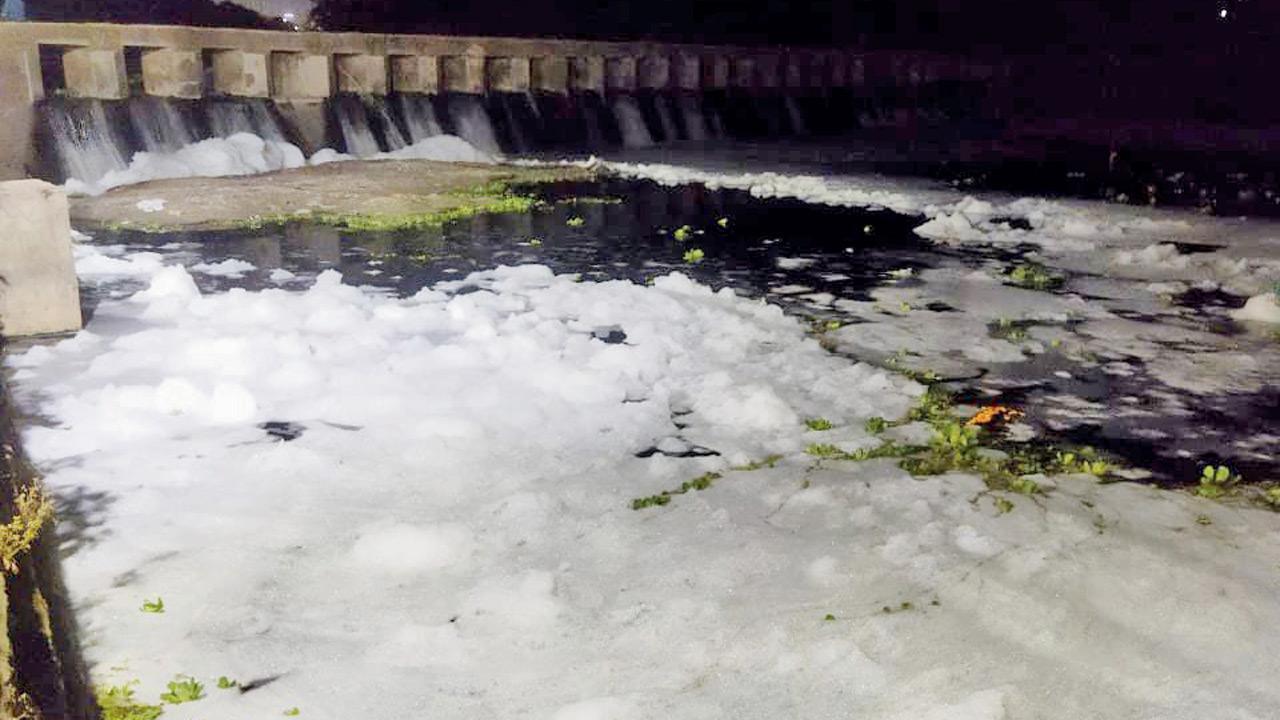Residents accuse municipal corporation of failing to curb untreated sewage and industrial waste, as white foam causes fish deaths

A thick layer of foam seen floating on the Pavana River near Kejudevi Bandara in Thergaon
A thick layer of white toxic foam was seen floating again on the Pavana River near Kejudevi Bandara in Thergaon, triggering alarm among residents on Tuesday night. The city's environmentalists and locals expressed concern over the river pollution. The sight of the foamy, chemical-laden water made the river appear like an icy stream rather than an urban water body, highlighting the growing pollution crisis in the industrial twin town.
ADVERTISEMENT
A few months ago, mass fish deaths were reported, with the municipal corporation attributing the cause to fertilisers mixing with the water. However, despite various clean-up drives and promises of action, the pollution continues. Residents complain that calls to the civic body’s environment department go unanswered, leaving them with no choice but to raise their voices through protests and social activism.
Anil Shrimant Ghodekar, a core committee member of the Thergaon Social Foundation and a local resident, said the pollution problem has persisted for four to five years. “The frequent pollution in these areas is due to untreated sewage from the municipal corporation and industrial wastewater being directly discharged into the river. The Pavana has lost its natural essence and has essentially turned into a sewer. The Pimpri-Chinchwad Municipal Corporation (PCMC) and its officials are solely responsible for this crisis,” Ghodekar said.
“Simply removing water hyacinths and installing a few cleaning machines at select locations does not mean the river is being revived. From Kejudevi Bandara to Morya Gosavi Ghat, severe pollution is visible. Further downstream, untreated sewage is being openly released, turning the river into a stagnant pool of filthy water,” he added.
In an effort to push for stronger action, local activists have created a WhatsApp group called PCMC Rivers Revival to coordinate their efforts. “We will launch major protests to restore this river to its sacred, life-giving form,” Ghodekar said.
Shubham Pande, founder of World for Nature, said his team receives five to six rescue calls daily for large animals entering human settlements in search of clean water. “Water pollution is increasing human-animal conflicts. Every year, thousands of fish die in the Pavana and Indrayani rivers due to contamination. Around 25 fish species have already vanished,” Pande said.
Officials from the Maharashtra Pollution Control Board (MPCB) and PCMC have yet to provide a long-term solution. MPCB Deputy Regional Officer Manchak Jadhav said his department had not received any complaints about the foam at Kejudevi Bandara but would investigate.
“There are multiple reasons for toxic foam formation. While no major industries are located near the Bandara, several nullahs discharge directly into it. Increased use of household detergents, which are not treated in sewage plants, also contributes. Changes in water flow and atmospheric conditions sometimes exacerbate the problem,” Jadhav said.
PCMC’s Chief Engineer and Head of the Environment Department, Sanjay Kulkarni, confirmed that a team had been sent to inspect the site. “Last time, we had to shut down a laundry that was releasing chemical-laden wastewater into the river, causing toxic foam. We are investigating this latest incident,” he said.
 Subscribe today by clicking the link and stay updated with the latest news!" Click here!
Subscribe today by clicking the link and stay updated with the latest news!" Click here!







